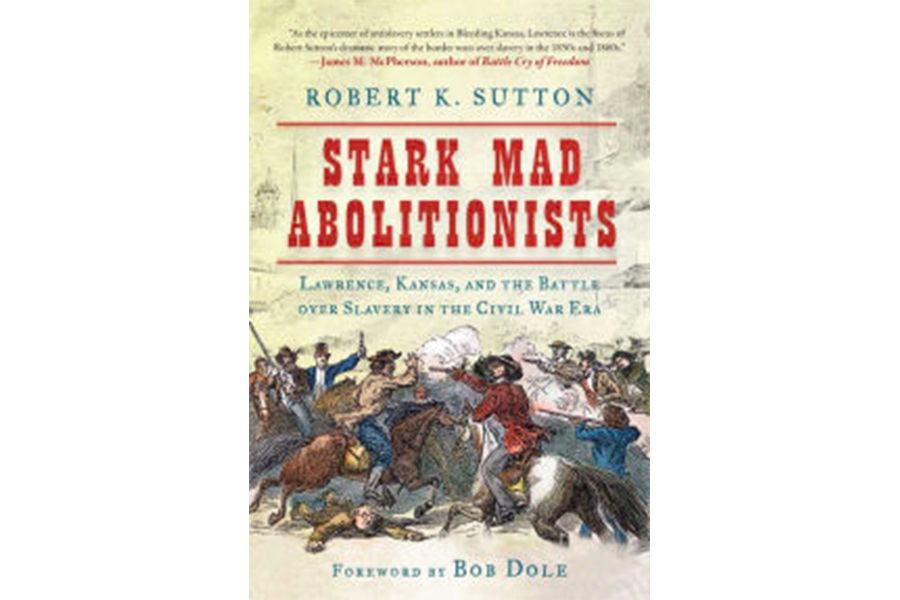'Stark Mad Abolitionists' is a dramatic and gripping account of the battle over slavery fought in Kansas
Loading...
The words “Bleeding Kansas” trigger memories from high-school history. Those who paid attention in class recall the violence had something to do with the issue of slavery in America.
Robert K. Sutton brilliantly brings academic memories to life in Stark Mad Abolitionists. Furthermore, readers of this thoroughly researched and passionately recounted story will come to understand the profoundly significant history of Lawrence, Kan., and care deeply about the drama of its founding. It’s a drama that involves blood, slavery, and people willing to sacrifice everything to oppose it.
The story begins in late spring 1854. “Boston was in an uproar,” Mr. Sutton writes, because an escaped slave named Anthony Burns had been captured by his “owner.” Two thousand federal troops escorted Burns to a boat that would take him back to Virginia.
Wealthy businessman Amos Adams Lawrence was among those who were angry. He wrote to his uncle that when he awakened one morning, he had become a “stark mad” abolitionist.
Lawrence quickly involved himself in the Massachusetts Emigrant Aid Company, an organization created to encourage and enable people opposed to slavery to move to the territory of Kansas. It was hoped that sufficient antislavery advocates would settle there to vote for it to become a “free state.”
Far from being “stark mad,” Lawrence himself was a generous man of quiet temperament. Ironically, he and his family “made their fortunes from buying, selling, and producing textiles, mostly made of cotton” picked by slaves in the South.
Sutton tells how Lawrence, as treasurer of the Emigrant Aid Company, paid a large portion of company costs, to the point where his own resources were dangerously depleted. Under his direction, a promising tract of land was found “near where the Wakarusa River entered the Kansas River, about forty miles west of the Missouri line.” On Aug. 1, 1854, the first settlers camped there. In recognition of Lawrence’s enormous contribution, the new town was named “Lawrence.”
Early on, “[t]he Emigrant Aid Company clearly had not prepared for the settlers it was encouraging to emigrate to Kansas.” Many quickly returned to home, dismayed by the rigors of a community where homes initially were made from straw.
Anti-slavery advocates also settled elsewhere in Kansas. But Lawrence was ground zero for some of the most important and dramatic events in the effort to make Kansas a free state. My biggest quibble with “Stark Mad” is the author didn’t include a map; location and proximity play a big role in these events.
Nonetheless, Sutton knows how to present history. He’s an experienced writer and a former chief historian of the National Park Service. With “Stark Mad,” he’s created not some bland historic site handout but a searing chronicle. Sutton tears back the curtain of time to reveal vivid images of Lawrence as well as the rest of Kansas and its people during the 1850s and the Civil War.
Sutton shows how the endurance of the people of Lawrence was tested. The town was dangerously close to Missouri, which was firmly and sometimes violently pro-slavery. In 1856, for example, less than two years after Lawrence’s founding, hundreds of troops and pro-slavery volunteers from Missouri destroyed much of the town.
Missouri’s influence went far beyond border hostilities. When the territorial legislature was to be elected, thousands of pro-slavery Missouri men crossed into Kansas to vote, threatening violence against election officials. This pro-slavery legislature was able for several years to circumvent the true wishes of Kansans. But in 1861 Kansas became the 34th American state – a free state.
The fieriest segment of Sutton’s book takes place during the Civil War, a conflict during which Kansans heartily fought and died for the Union side. William Clarke Quantrill, the commander of a large force of “bushwhackers” – Confederate guerrilla fighters – brutally attacked and destroyed much of Lawrence.
Sutton’s writing is orderly and thoughtful. And Sutton doesn’t dramatize this grisly episode. But neither does he spare us the nightmare details of the murder of approximately 200 Lawrence men and boys.
“The devastation was horrendous, but the outpouring of generosity was remarkable,” Sutton comments. With help from places like St. Louis, and people like Amos Lawrence, the community rebuilt.
Two years later, the war was over and “[p]eace also brought prosperity.” Lawrence’s stalwart Congregational minister, Rev. Richard Cordley, commented that “we could retire at night without fear of alarm, and work by day without fear of attack.... One hardly needs to say that we enjoyed it as few people enjoy peace and quiet."






